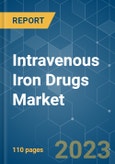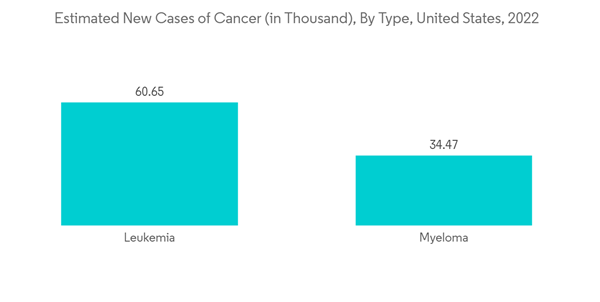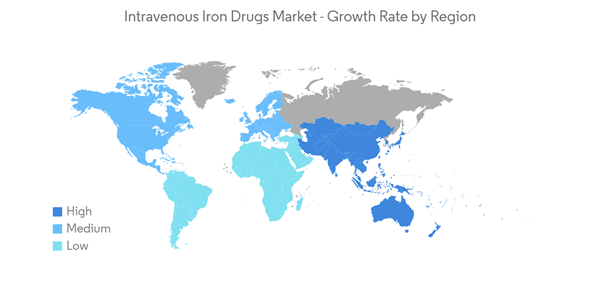The intravenous iron drugs market is expected to grow at a significant CAGR of 8.35% during the forecast period.
During the pandemic, there is a slight decline in the intravenous iron drugs market due to the disruption of the supply chain and manufacturing process. But the market recovered soon and has grown subsequently, as there was a high demand for intravenous iron drugs, due to the increased risk of chronic kidney failure (CKD)-related anemia in COVID-19 patients. Furthermore, as per the article published by PubMed in August 2021, an older patient with numerous concomitant conditions who was hospitalized for COVID-19 was treated for iron deficient anemia with ferric carboxymaltose (Ferinjectâ, Vifor International). The medication caused the hemoglobin (Hb) to return to normal, the iron reserves to quickly restock, and the transferrin saturation to simultaneously improve. In cases of severe patients with diffuse coagulopathy, like the one in the present case, ferric carboxymaltose can be thought of as a viable option to treat anemia while a patient is being treated in a hospital for COVID-19 and avoid transfusion regimens. Hence as per the facts mentioned above, COVID-19 had a significant impact on the intravenous iron drugs market. However, as the pandemic has subsided, the studied the market is expected to have a stable growth during the forecast period of the study.
Certain factors driving the market growth include the increasing prevalence of target diseases such as chronic kidney disease-related anemia, irritable bowel syndrome, cancer-related anemia, disadvantages of oral iron drugs, and an increasingly aging population. For instance, as per the article published by PubMed in July 2022, a study was conducted which showed that IV iron for the treatment of cancer-induced anemia (CIA) reduces the need for red blood cells (RBC) transfusions and is not associated with adverse events. IV iron for the treatment of cancer-induced anemia should be considered in clinical practice.
Furthermore, government initiatives, research, and development in the field of IV iron drugs and the presence of competitors boost the market growth. For instance, in February 2021, the National Medical Products Administration (NMPA) in China approved Monofer (Ferric Derisomaltose) injection 100 mg/mL developed by Pharmacosmos. Monofer is an intravenous iron that is used in adult patients who have an intolerance to oral iron or unsatisfactory response to oral iron, or when there is a clinical need to administer iron quickly.
Apart from this, iron deficiency anemia is another common consequence of inflammatory bowel disease (IBD). For instance, according to an article published by PubMed Central in November 2022, iron deficiency (ID) and anemia in patients with inflammatory bowel disease (IBD) is often associated with a reduced quality of life. The article also stated that a study was conducted among a few IBD patients in the Netherlands, and it was found that the overall prevalence of anemia, iron deficiency and iron deficiency anemia was 18.0%, 43.4%, and 12.2%, respectively. Intravenous iron drugs are preferred for the treatment of IBD associated with iron deficiency anemia. Oral iron supplementation is the most frequent iron-deficient anemia treatment; however, it has been linked to gastro intestinal (GI) side effects such as constipation and bloating. Due to the lack of exposure to the intestinal lumen, intravenous iron drugs do not elicit gastro intestinal adverse effects. Therefore, chronic diseases such as CKD and IBD have resulted in persistent and prolonged anemia, fueling the growth of the intravenous iron drugs market.
Hence, due to the factors mentioned above such as the government initiatives, research, and development in the field of IV iron drugs, and increasing effectivity of IV iron drugs in cancer related anemia and irritable bowel disease, the studied market is anticipated to grow over the forecast period. However, adverse reactions associated with intravenous iron drugs restrain the market growth.
Treatment for iron deficiency anemia with FCM aims to restore normal hemoglobin (Hb) levels, replenish iron storage, and normalize red cell levels. Other objectives include reducing anemia-related symptoms and improving health-related quality of life. Ferric carboxy maltose is a new therapy option that has a low risk of hypersensitivity events and is well tolerated at high doses besides being safe, effective, and cost-efficient compared to other available intravenous iron drug treatments.
Several studies have assured the safety and effectiveness of FCM over other intravenous iron drugs. For instance, as per the article published by PubMed Central in June 2022, FCM effectively, safely, and quickly treats patients with moderate-to-severe anemia in about 4 weeks. The clinical use of FCM in real-world scenarios is supported by doctors' favorable clinical impressions of its efficacy and safety. Hence such development and studies related to FCM are likely to boost the market growth over the forecast period. Moreover, FCM has been increasingly used in the treatment of cancer-related anemia, thus the increasing incidence of certain cancer types such as lymphoma, leukemia and multiple myeloma is also expected to boost the segment growth.
Furthermore, the presence of competitors, product launches, research, and development in the field of FCM fuels market growth. For instance, the clinical trial report published by the Journal of Marine Medical Society in October 2021, stated that an appropriate option for the treatment of postpartum anemia is ferric carboxymaltose (FCM), a more recent dextran-free iron formulation that permits single and higher doses (up to 1000 mg) of IV iron infusion. Furthermore, injection of FCM in the dose of 1000 mg given in a single dose before discharge in postpartum women helped in reducing postpartum anemia (PPA) without any significant adverse effects. Hence such substantial reports showing the advantages of FCM promotes market growth over the forecast period.
Therefore, factors such as best-in-class safety and efficacy, reduced dosing interval, improved clinical significance, increasing incidence of certain cancer types such as lymphoma, leukemia and multiple myeloma, and cost-effectiveness have fuelled the growth of the FCM segment in the intravenous iron drugs market.
According to the data updated by CDC, in 2021, chronic kidney disease (CKD) affects 15% of adults in the United States. CKD affects more than one in seven persons in the United States accounting for approximately 37 million people in 2021. Age is also the biggest factor for CKD in the United States. For instance, CKD is more common in adults over 65 years old (38%) than in people 45-64 years old (12%) or 18-44 years old (18-44 years old) (6%). Anemia is a complication that affects most individuals with advanced CKD. The relative deficiency of erythropoietin production is the major driver of anemia. Iron deficiency contributes to impaired erythropoiesis in CKD patients. People who have CKD are prone to use intravenous iron products to improve their health and body iron levels. This propels market growth of intravenous iron drugs over the forecast period.
Furthermore, gastrointestinal illness such as irritable bowel disease (IBD) is also the most common complication in the United States and Canada. According to the Government of Canada, 260,000 Canadians were affected by IBD in 2021. Patients with IBD are commonly found to have iron deficiency anemia (IDA) secondary to chronic blood loss, and impaired iron absorption due to tissue inflammation. Hence the chance of using IV iron drugs in the studied area is boosted due to the high prevalence of such diseases.
Moreover, increasing product launches by key market players are also exhancing the market growth. For instance, in July 2021, Sandoz, one of the global leaders in generic and biosimilar medicines, launched the first generic high-dose intravenous iron, Ferumoxytol Injection, to treat the United States patients with iron deficiency anemia.
Hence, due to the aforementioned factors such as the increasing product launches, the high prevalence of diseases such as irritable bowel disease and chronic kidney disease, are expected to boost the growth of the market in the North American region during the forecast period of the study.
This product will be delivered within 2 business days.
During the pandemic, there is a slight decline in the intravenous iron drugs market due to the disruption of the supply chain and manufacturing process. But the market recovered soon and has grown subsequently, as there was a high demand for intravenous iron drugs, due to the increased risk of chronic kidney failure (CKD)-related anemia in COVID-19 patients. Furthermore, as per the article published by PubMed in August 2021, an older patient with numerous concomitant conditions who was hospitalized for COVID-19 was treated for iron deficient anemia with ferric carboxymaltose (Ferinjectâ, Vifor International). The medication caused the hemoglobin (Hb) to return to normal, the iron reserves to quickly restock, and the transferrin saturation to simultaneously improve. In cases of severe patients with diffuse coagulopathy, like the one in the present case, ferric carboxymaltose can be thought of as a viable option to treat anemia while a patient is being treated in a hospital for COVID-19 and avoid transfusion regimens. Hence as per the facts mentioned above, COVID-19 had a significant impact on the intravenous iron drugs market. However, as the pandemic has subsided, the studied the market is expected to have a stable growth during the forecast period of the study.
Certain factors driving the market growth include the increasing prevalence of target diseases such as chronic kidney disease-related anemia, irritable bowel syndrome, cancer-related anemia, disadvantages of oral iron drugs, and an increasingly aging population. For instance, as per the article published by PubMed in July 2022, a study was conducted which showed that IV iron for the treatment of cancer-induced anemia (CIA) reduces the need for red blood cells (RBC) transfusions and is not associated with adverse events. IV iron for the treatment of cancer-induced anemia should be considered in clinical practice.
Furthermore, government initiatives, research, and development in the field of IV iron drugs and the presence of competitors boost the market growth. For instance, in February 2021, the National Medical Products Administration (NMPA) in China approved Monofer (Ferric Derisomaltose) injection 100 mg/mL developed by Pharmacosmos. Monofer is an intravenous iron that is used in adult patients who have an intolerance to oral iron or unsatisfactory response to oral iron, or when there is a clinical need to administer iron quickly.
Apart from this, iron deficiency anemia is another common consequence of inflammatory bowel disease (IBD). For instance, according to an article published by PubMed Central in November 2022, iron deficiency (ID) and anemia in patients with inflammatory bowel disease (IBD) is often associated with a reduced quality of life. The article also stated that a study was conducted among a few IBD patients in the Netherlands, and it was found that the overall prevalence of anemia, iron deficiency and iron deficiency anemia was 18.0%, 43.4%, and 12.2%, respectively. Intravenous iron drugs are preferred for the treatment of IBD associated with iron deficiency anemia. Oral iron supplementation is the most frequent iron-deficient anemia treatment; however, it has been linked to gastro intestinal (GI) side effects such as constipation and bloating. Due to the lack of exposure to the intestinal lumen, intravenous iron drugs do not elicit gastro intestinal adverse effects. Therefore, chronic diseases such as CKD and IBD have resulted in persistent and prolonged anemia, fueling the growth of the intravenous iron drugs market.
Hence, due to the factors mentioned above such as the government initiatives, research, and development in the field of IV iron drugs, and increasing effectivity of IV iron drugs in cancer related anemia and irritable bowel disease, the studied market is anticipated to grow over the forecast period. However, adverse reactions associated with intravenous iron drugs restrain the market growth.
Key Market Trends
Ferric Carboxy Maltose Segment is Expected to Hold a Significant Market Share Over the Forecast Period
FCM (Ferric Carboxy Maltose) is a new parenteral iron drug that is the first of its kind to be approved by the United States FDA for quick and high-dose iron replenishment. It is used as an iron replacement drug for the treatment of iron deficiency anemia (IDA) in adult patients with oral iron intolerance, a poor response to oral iron, or non-dialysis-dependent chronic kidney disease.Treatment for iron deficiency anemia with FCM aims to restore normal hemoglobin (Hb) levels, replenish iron storage, and normalize red cell levels. Other objectives include reducing anemia-related symptoms and improving health-related quality of life. Ferric carboxy maltose is a new therapy option that has a low risk of hypersensitivity events and is well tolerated at high doses besides being safe, effective, and cost-efficient compared to other available intravenous iron drug treatments.
Several studies have assured the safety and effectiveness of FCM over other intravenous iron drugs. For instance, as per the article published by PubMed Central in June 2022, FCM effectively, safely, and quickly treats patients with moderate-to-severe anemia in about 4 weeks. The clinical use of FCM in real-world scenarios is supported by doctors' favorable clinical impressions of its efficacy and safety. Hence such development and studies related to FCM are likely to boost the market growth over the forecast period. Moreover, FCM has been increasingly used in the treatment of cancer-related anemia, thus the increasing incidence of certain cancer types such as lymphoma, leukemia and multiple myeloma is also expected to boost the segment growth.
Furthermore, the presence of competitors, product launches, research, and development in the field of FCM fuels market growth. For instance, the clinical trial report published by the Journal of Marine Medical Society in October 2021, stated that an appropriate option for the treatment of postpartum anemia is ferric carboxymaltose (FCM), a more recent dextran-free iron formulation that permits single and higher doses (up to 1000 mg) of IV iron infusion. Furthermore, injection of FCM in the dose of 1000 mg given in a single dose before discharge in postpartum women helped in reducing postpartum anemia (PPA) without any significant adverse effects. Hence such substantial reports showing the advantages of FCM promotes market growth over the forecast period.
Therefore, factors such as best-in-class safety and efficacy, reduced dosing interval, improved clinical significance, increasing incidence of certain cancer types such as lymphoma, leukemia and multiple myeloma, and cost-effectiveness have fuelled the growth of the FCM segment in the intravenous iron drugs market.
North America is Expected to Hold a Significant Share in the Market and Expected to do Same in the Forecast Period.
The rising prevalence of chronic kidney disease, gastrointestinal illnesses, and cancers in North America contributed to its regional dominance in the intravenous iron drugs market over the forecast period. Besides this, the approval and launch of new intravenous medications in the region have further propelled the market growth.According to the data updated by CDC, in 2021, chronic kidney disease (CKD) affects 15% of adults in the United States. CKD affects more than one in seven persons in the United States accounting for approximately 37 million people in 2021. Age is also the biggest factor for CKD in the United States. For instance, CKD is more common in adults over 65 years old (38%) than in people 45-64 years old (12%) or 18-44 years old (18-44 years old) (6%). Anemia is a complication that affects most individuals with advanced CKD. The relative deficiency of erythropoietin production is the major driver of anemia. Iron deficiency contributes to impaired erythropoiesis in CKD patients. People who have CKD are prone to use intravenous iron products to improve their health and body iron levels. This propels market growth of intravenous iron drugs over the forecast period.
Furthermore, gastrointestinal illness such as irritable bowel disease (IBD) is also the most common complication in the United States and Canada. According to the Government of Canada, 260,000 Canadians were affected by IBD in 2021. Patients with IBD are commonly found to have iron deficiency anemia (IDA) secondary to chronic blood loss, and impaired iron absorption due to tissue inflammation. Hence the chance of using IV iron drugs in the studied area is boosted due to the high prevalence of such diseases.
Moreover, increasing product launches by key market players are also exhancing the market growth. For instance, in July 2021, Sandoz, one of the global leaders in generic and biosimilar medicines, launched the first generic high-dose intravenous iron, Ferumoxytol Injection, to treat the United States patients with iron deficiency anemia.
Hence, due to the aforementioned factors such as the increasing product launches, the high prevalence of diseases such as irritable bowel disease and chronic kidney disease, are expected to boost the growth of the market in the North American region during the forecast period of the study.
Competitive Landscape
The intravenous iron drugs market is consolidated and consists of a few players across the globe. In terms of market share, a few of the major players are currently dominating the market. Some of the companies that hold a significant market share are CSL Limited (Vifor Pharma Management Ltd.), AbbVie (Allergan), Covis Pharma GmbH (AMAG Pharmaceuticals, Inc), Sanofi, Pharmocos, Shield Therapeutics Rockwell Medical, American Regent among others.Additional benefits of purchasing the report:
- The market estimate (ME) sheet in Excel format
- 3 months of analyst support
This product will be delivered within 2 business days.
Table of Contents
1 INTRODUCTION
4 MARKET DYNAMICS
5 MARKET SEGMENTATION (Market Size by Value - USD Million)
6 COMPETITIVE LANDSCAPE
Companies Mentioned (Partial List)
A selection of companies mentioned in this report includes, but is not limited to:
- CSL Limited (Vifor Pharma Management Ltd.)
- Covis Pharma GmbH (AMAG Pharmaceuticals, Inc)
- Daiichi Sankyo Company, Ltd.
- Sanofi S.A.
- Pharmacosmos A/S
- Shield Therapeutics Plc
- AbbVie (Allergan)
- Rockwell Medical
- Americal Reagent
- Pfizer Inc.
- Zydus Group
- Keryx Biopharmaceuticals Inc
Methodology

LOADING...










